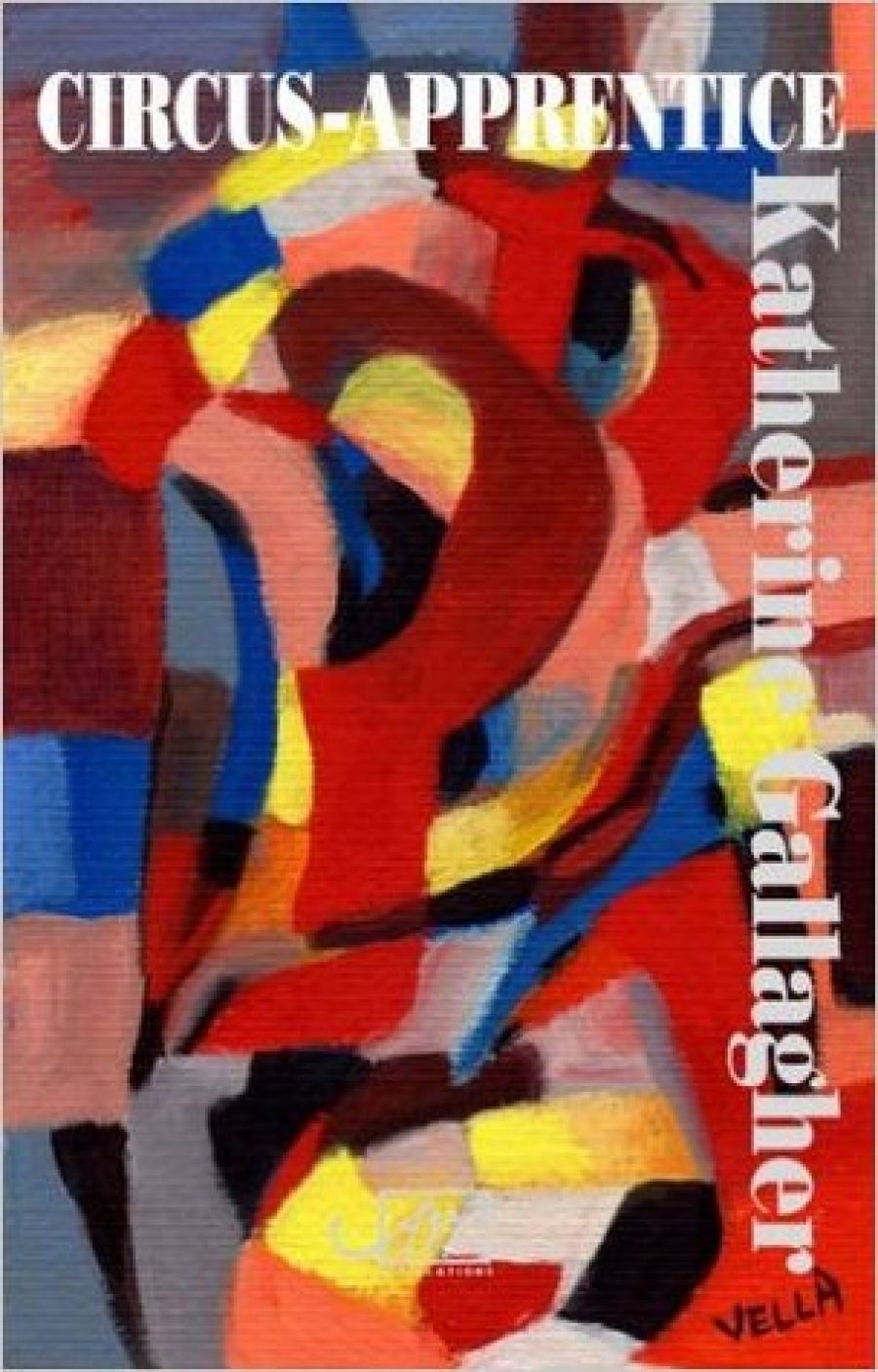
- Free Article: No
- Contents Category: Poetry
- Review Article: Yes
- Online Only: No
- Custom Highlight Text:
Katherine Gallagher’s is a poetry of small spaces and objects, tiny hollows of memory that momentarily glow, incandescent, in the imagination: ‘knotted roots / reaching down into the riverbed’, ‘faces mottled in eucalyptus shade’, that place ‘beside the pond, in foaming clusters / creamy flowers of meadowsweet; / and there’s goatsbeard (‘jack-go-to-bed-at-noon’) / bird’s-foot trefoil, majoram and reeds.’ These latter lines are from the poem ‘Summer Odyssey (Railway Fields, for D.B.)’, an occasional poem for a small piece of land ‘Between Green Lane and the New River’s / four hundred-year-old waterway’. The poet spins from the ordinary and the overlooked a world of intricacy and quiet sensual power.=
- Book 1 Title: Circus-Apprentice
- Book 1 Biblio: Arc Publications, ₤8.99 pb, 101 pp
There is also much common sense in these poems, a gently guiding, factual mind at work, delighted and honoured by familial love, the repetitions of a world of seasons, the observed proportions of suburban life. There is a loving attentiveness in the poems. Just beneath the mundane surfaces of the world, the poet illuminates the tiny beauties to be found there. How different from the high, abstract ambitions of the modernists, or the high-class histrionics of a Sylvia or Ted, or the trenchant politics of a Judith Wright or Les Murray, all of whom in different ways used the natural and domestic worlds as their ideological and sensuous palette. Here, Henlys Corner, a ‘suburban patch under threat’, can inspire a song for ‘February: already catkins, / hanging green fires, coppices heady / by Mutton Brook Stream’ (‘Under Threat’). Ambition gives way in Gallagher’s work to a humility of craft and view. Far from creating a resounding prophetic voice, or a strident critical one, Gallagher’s poetry, like her subject matter, is quietly resonant, and it accrues in its effects.
Gallagher spent the first thirty years of her life in Australia; for the past forty she has lived mainly in London, with nine years spent in Paris. But there is no grandstanding cosmopolitanism or expatriatism evident in the poetry, as we encounter a voice gently moving along with knowledge and sense, treasuring family memories of the river under eucalypts, or dancing on the farm with dad ‘there on the edge / of my dream with his face slightly pained – / ... the weight of days holding his feet / to the boards’ (‘Dancing on the Farm’). In a 2006 interview with Professor Lidia Vianu of the University of Bucharest, Gallagher spoke of her deeply remembered Australian beginnings:
My life has been greatly affected by growing up on a farm in central Victoria at Eastville, a small place consisting of an Anglican church, a post office and a one-teacher-13-pupil-school. I was second in a 4th generation Irish-Australian family of 8 children, and my Irish heritage is very important to me. Eastville, with its grassy paddocks, classic eucalypts, undulating hills and stretching skies, gave me a lasting sense of sky and landscape. Beyond the house paddocks were Maldon, my birthplace, and Mt. Tarrengower, settled into the bluehaze. This childhood was ‘the quiet life’ par excellence – ‘All that silence, as if nothing’s / happening under the sky,’
This ‘as if’ is expressive of Gallagher’s art. One ‘Australian’ poem, ‘Laanecoorie’, stands out in the collection. The poem’s form is a variation on the pantoum, which traditionally employs four-line stanzas, with the second line of each becoming the first line of the following. The repetition of these somewhat longer-than-usual lines creates an echoing, haunted feel, appropriate for a poetry of loss and memory. Here the setting is Australia, on the banks of the Loddon river, forty years ago: ‘The Loddon, my first river’, has resonances of the phrase ‘my first death’, as the Loddon indeed becomes ‘Lethe’. Gallagher’s long, sensuous lines gently but persistently unwind the memory of childhood exuberance and childhood death, as cousins ‘swam full-pelt into the rippling swell ... // carrying with us always the mud and the stones and the memory / of Laanecoorie on the Loddon, with its long Aboriginal name’. How fascinating – such a brightly lit, tragic Australian memory, with its Aboriginal place names, Australian vernacular and references – ‘prickly January’, ‘magpies, kookaburras and wagtails swooped by’, ‘the Loddon, fringed by stout red gums, with their knotted roots’ – carried around for many decades in an altogether different place.
Perhaps it is the contrast with ‘Laanecoorie’s’ sombre tones that explains the effect of wittiness in the placement of the next poem in Gallagher’s collection Circus-Apprentice: the delightfully whimsical ‘The Year of the Tree’. Set as far away from the Loddon as possible, in the London underground: ‘I carried a tree / through the Underground’ presents strange, twisted little echoes of Eurydice or Orpheus, busy with their subversive, hopeful activities. Here, the poet figure carries a tree: ‘the oak I was lugging ... the start of a forest. / When people stared, // Relax, I said, / it’s a tree, not a gun.’
The same cultured whimsy informs the lovely sequence After Kandinsky, a suite of eleven parts that concludes Circus-Apprentice. The handsome, seductive colours and forms of Kandinsky’s art peep out from Gallagher’s worded and feeling frames: ‘Circles rim shades: the drums of colour / summoning your heart. The atmosphere is as calm / as can be imagined: that calm after the shearers / have been through, taking their pickings, / while black-ringed moons pitch shadows, / putting out antennae, snail-like, / for a new slide forward. They hide a residue of faith.’ These final words also apply to the gentle, insistent poems of Circus-Apprentice. The poems of the suite are attentive to the forms of Kandinsky, as they also twist in a lovely dollop of Australian imagination: Kandinsky’s delicate, busily sensuous arabesques infused with ‘that calm after the shearers / have been through’.


Comments powered by CComment